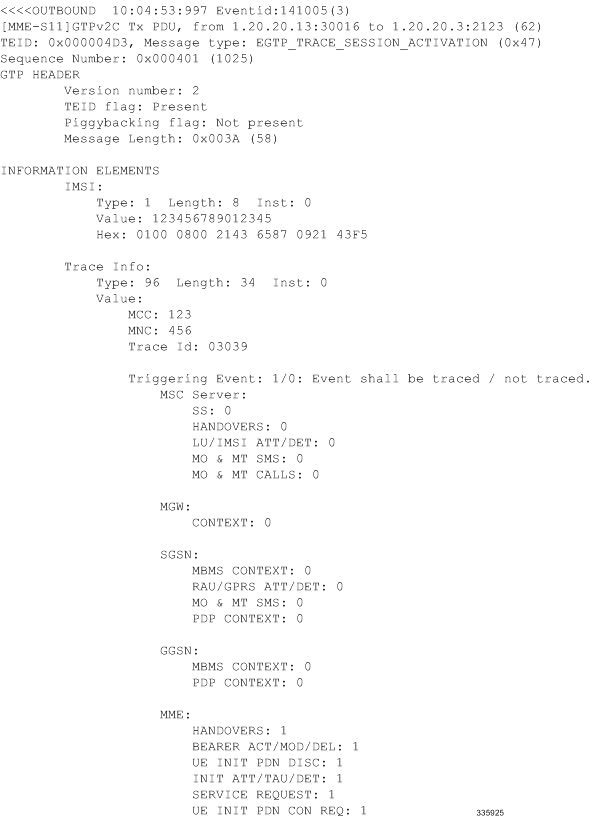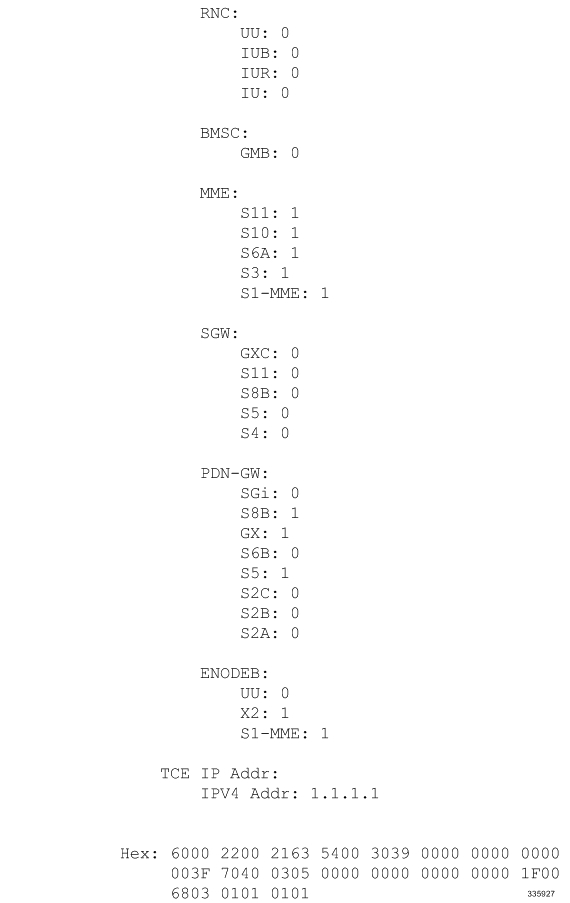Session Tracing Overview
Session Trace capability enables an operator to trace subscriber activity at various points in the network and at various levels of detail. The trace can be subscriber initiated (that is, signaling based) or management initiated from the CLI (Command Line Interface) and can be propagated throughout the access cloud via the various signaling interfaces available to the UMTS/EPC network element.
Essentially, the Session Trace capability records and forwards all control activity for the monitored subscriber on the monitored interfaces. This is typically all the signaling and authentication/subscriber services messages that flow when a User Equipment (UE) connects to the access network.
All monitored activity is sent to an off-line Trace Collection Entity (TCE) using a standards-based XML format over a File Transfer Protocol (FTP) or secure FTP (sFTP) connection.
 Important |
Session tracing is a resource intensive application in terms of CPU utilization and will affect call rates and data throughput when in use. The use of this feature in a production network should be restricted to minimize the impact on existing services. |
 Important |
For 19.2 and prior StarOS releases, both the FTP and SFTP options are available. In release 20.0 and higher trusted StarOS builds only the SFTP option is supported; FTP is not supported for the Session Trace function in release 20.0 and higher trusted StarOS builds. |
As can be seen in the following illustration, of the three Network Elements (NEs) shown, one NE is actively tracing data on one or more interfaces. All data collected is stored as files in an XML format and then transferred to the collection entity using (S)FTP or FTP. Note that IPv4 or IPv6 connectivity is required between the NE and the TCE in order to transfer the files.

Session Trace Types
There are three types of session trace functions available.
- Management Trace: The operator sends an activation request via the CLI directly to the UMTS/EPC network element where the trace is to be initiated. The network element establishes the trace session and waits for a configured trigger event to start actively tracing. When management-initiated trace activations are executed at the network element, they are never propagated to other NEs whether or not it is involved in the actual recording of the call.
- Random Trace: Enables or disables the subscriber session trace functionality based on a the random trace on the UMTS/EPC network element. The trace control and configuration parameters are configured directly in the specified network element through the random trace CLI command. There is no propagation of trace parameters in random based trace activation. This NE shall not propagate the received data to any other NEs whether or not it is involved in the actual recording of the call. If enabled, the subscriber selection will be based on random logic all instances of session on the specified UMTS/EPC network element.
- Signaling Trace: With a signaling based activation, the trace session is indicated to the UMTS/EPC network element across a signaling interface via a trace invocation message. This message can either be piggybacked with an existing bearer setup message (in order to trace all control messages) or by sending a separate trace invocation message (if the user is already active). Signaling based activations are always propagated to neighboring NEs even if the current NE does not participate in the trace (either they not enabled by configuration or not present in the configured trace parameters).
 Important |
Note that the maximum number of unique International Mobile Subscriber Identification (IMSI) numbers or International Mobile Equipment Identification (IMEI) numbers cannot exceed 32; however, each NE can trace all 32 unique IMSI/IMEIs. |
 Caution |
Session tracing is a resource intensive application in terms of CPU utilization and will affect call rates and data throughput when in use. The use of this feature in a production network should be restricted to minimize the impact on existing services. |
Session Trace Activation
Activation of a trace is similar whether it be via the management interface or via a signaling interface. In both cases, a trace session state block is allocated which stores all configuration and state information for the trace session. In addition, an (S)FTP connection to the Trace Collection Entity (TCE) is established if one does not already exist. The NE will store up to 2 MB of XML data on its local disk to allow for the (S)FTP connection to be established and the files to be pushed to or pulled from the TCE.
If the session to be traced is already active, tracing may begin immediately. Otherwise, tracing activity waits until the start trigger occurs (typically when the subscriber/UE under trace initiates a connection). A failure to activate a trace (due to the maximum being exceeded or some other failure reason) results in a notification being sent to the TCE indicating the failure.
Session Trace Deactivation
Deactivation of a Trace Session is similar whether it was management or signaling activated. In either case, a deactivation request is received by the NE that contains valid trace reference results in the de-allocation of the trace session state block and a flushing of any pending trace data. In addition, if this is the last trace session to a particular TCE, the (S)FTP connection to the TCE is released after the last trace file is successfully transferred to the TCE.
Data Collection
Data collection is done inline by each of the NEs. In order to reduce the overhead on a per-control packet basis, a copy of the entire packet is made and stored into an internal database (DB) of packets.
The local internal path for the trace database is /hd-raid/trace.
This storage is done regardless of the trace depth. After xx bytes (or xx messages) have been stored or a configurable number of seconds have elapsed, all cached data is encoded in the standard XML format and written out to a file to be forwarded to/pulled from the TCE. If there is no TCE active, the UMTS/EPC network element will continue to cache data and create trace files as long as there is space available before stopping the trace recording session. Once the connection to the TCE becomes active, all cached data will be sent immediately to the TCE.
Data Forwarding
When a session is activated, the IP address of the TCE is supplied in the session activation request. Upon activation and if the push mode is used, a check is made to see if there is already an (S)FTP connection to the TCE. If so, it is used for all traffic associated with this trace session. If not, an (S)FTP connection is made to the TCE using the supplied IP address. Data is buffered locally and trace files generated until the connection is established. Once the connection is established, all previously created trace files are sent to the TCE. Note that the (S)FTP connection is established to the TCE at session activation regardless of whether or not a trace recording session has been triggered. The (S)FTP connection is maintained until the trace session is deactivated.
Note the following:
- If a default TCE IP Address is supplied when the trace capability is configured, a default (S)FTP connection is made to the remote TCE.
- The TCE can be reachable either via IPv4 or IPv6 addressing. The supplied TCE address indicates the version.
- If the push mode is not used, the files are stored on the local hard drive (/hd-raid/trace) and must be pulled off by the TCE using FTP or SFTP.
Supported Standards
Support for the following standards and requests for comments (RFCs) have been added for the Session Trace feature:
- 3GPP TS 32.421 V8.5.0 (2009-06): 3rd Generation Partnership Project; Technical Specification Group Services and System Aspects; Telecommunication management; Subscriber and equipment trace: Trace concepts and requirements (Release 8)
- 3GPP TS 32.422 V8.6.0 (2009-09): 3rd Generation Partnership Project; Technical Specification Group Services and System Aspects; Telecommunication management; Subscriber and equipment trace; Trace control and configuration management (Release 8)
- 3GPP TS 32.423 V8.2.0 (2009-09): 3rd Generation Partnership Project; Technical Specification Group Services and System Aspects; Telecommunication management; Subscriber and equipment trace: Trace data definition and management (Release 8)



 Feedback
Feedback